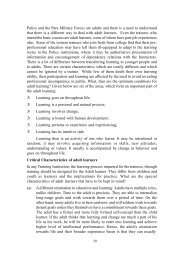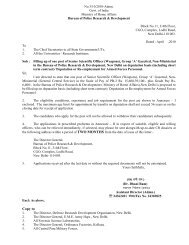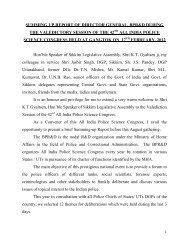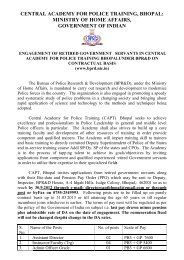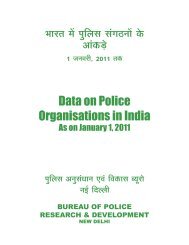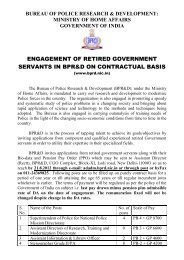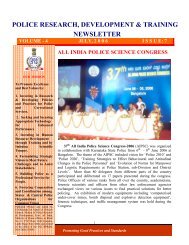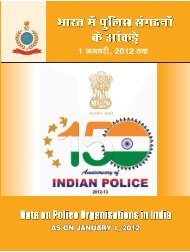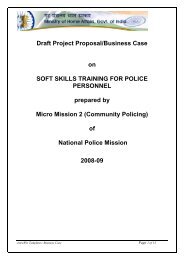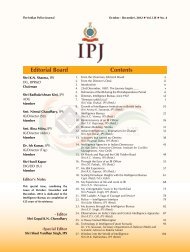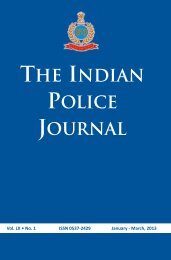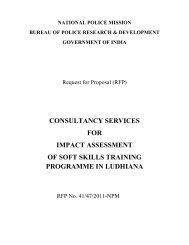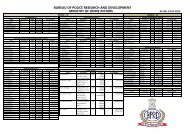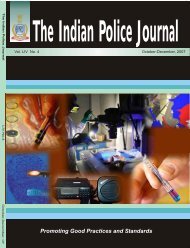April - June 2010 - Bureau of Police Research and Development
April - June 2010 - Bureau of Police Research and Development
April - June 2010 - Bureau of Police Research and Development
- No tags were found...
You also want an ePaper? Increase the reach of your titles
YUMPU automatically turns print PDFs into web optimized ePapers that Google loves.
Conviction Rate : A Reality Check<strong>of</strong> the maximum punishment prescribed inthe law for the said <strong>of</strong>fence for eachconvicted accused. Annual average is givenin the following table:Table-2: Annual Average <strong>of</strong> SentenceYear Average quantum <strong>of</strong> sentenceawarded as % age <strong>of</strong>maximum punishment1980 10.1%1981 16.1%1982 17.28%1983 09.0%1984 04.05%Overall 12.86%Thus, on an average, a convicted accused wassentenced to undergo only 12.86% <strong>of</strong> themaximum sentence prescribed for the <strong>of</strong>fencefor which he was convicted. This shows thatcourts take an extremely lenient view. It almostamounts to negating the objects in furtherance<strong>of</strong> which the law was enacted in the first place.It is pertinent to mention that while calculatingthe figures given in the above table, theactual sentence awarded to the convictedaccused has been compared with the maximumpunishment prescribed for the most severe<strong>of</strong>fence for which he was convicted. Forexample, if an accused was convicted onthree counts, the maximum punishmentprescribed for the most severe <strong>of</strong>fence wastaken as the denominator. Courts in Indiagenerally sentence convicted accused personsto undergo sentences concurrently. However,as per section 31 Cr. PC, the court maysentence an accused to undergo imprisonmenton each count consecutively i.e. one afterthe other. If the figures in the above tableare recalculated on the basis <strong>of</strong> this permissiblemaximum i.e. sum total <strong>of</strong> maximum prescribedpunishment for each <strong>of</strong>fence, the results willbe even more disappointing.Justice Delayed is Justice DeniedAs already reported above :Average time taken ininvestigation:13.4 monthsAverage time taken in trial: 7 years4 monthsAverage time takenin deciding appeal:9 years11 monthsThe Sixty Six appeals are still pending.Average time taken in deciding appeals hasbeen calculated on the basis <strong>of</strong> only 37appeals which have been decided so far.Once the remaining appeals are also decided<strong>and</strong> reflected in the calculations, the averagetime taken in deciding appeals is likely togo up further.The above figures show that trial <strong>and</strong>appeals together have taken 17 years onan average which is more than 15 timesthe time taken during investigation. In thepolice, delays in investigation are viewedseriously. Taking longer than a few monthsto complete investigation is considered asa pr<strong>of</strong>essional sin. However, the abovefigures clearly show that investigation takesfar less time than trial <strong>and</strong> appeals. Evenif time taken to complete investigation ishalved, it will not make any significant dentin the overall time taken by the judicialprocess. Moral <strong>of</strong> the story (for CSI topbrass) is: Focus on quality <strong>of</strong> investigation,rather than emphasizing on statisticswhich has no impact on the groundsituation !The Indian <strong>Police</strong> Journal Vol. LVII-No. 2, <strong>April</strong>-<strong>June</strong>, <strong>2010</strong> 29➢



